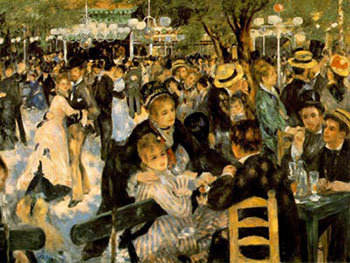Raymond Rudorff, The Belle Epoque; Paris in the Nineties (1)
The World of Montmartre
THE PLEASURE CAPITAL
Like the Nineties elsewhere, the 1890's in Paris now conjure up images of
pleasure and gay abandon. In 1887, in his book Paris, Augustus Hare already wrote that "pleasure at Paris becomes business; indeed, a large portion of the upper classes of Parisians have no time for anything else". That Paris was first and foremost a Mecca for frivolous sensualists with money to spend seemed confirmed to the eyes of the many foreigners who came to see the 1889 Exposition. No other great world capital seemed to cater so efficiently and with such devotion to the needs of the pleasure-seeker. At the same time as the Exposition, the fall of Boulangisme [a right-wing movement of the 1880s designed to overthrow the Third Republic] and the rise of the Eiffel Tower, Montmartre became the centre of Paris entertainment. In 1889, the Moulin Rouge opened its doors, the great red wooden sails of its windmill above the entrance began to turn and an entire decade in the city's life began to pass from history into myth.
Montmartre, la butte sacrée, was not only a place of pleasure but of pilgrimage. It was the sacred hill of Saint Denis, the first bishop of Paris and the traditional site of his martyrdom. The 417-feethigh eminence had a turbulent history. Henri of Navarre had bombarded the city from its heights, in 1589, shortly before becoming King Henri IV. A last desperate battle had been fought there against the Allies in 1814. Montmartre had been a commune outside the administrative area of Paris until 1860 when it had been annexed by the capital, and in 1871 it had become a symbol for the rebellious Commune when mutinous soldiers had murdered the generals Thomas and Lecomte before seizing the cannon stationed on the heights from the National Guard. Four years later, the hill was chosen as the site of the symbol of national reconciliation: the Sacré Coeur. By the end of 1889, long before the neo-Byzantine, neo-Romanesque basilica had been completed, the foot of the butte had become a new Mecca to pleasure seekers and a new Babylon to the censorious.
Auguste Renoir, Moulin de la Galette (1876)
The highest part of the hill was a picturesque spot in 1889. A few of its many windmills still survived, wine had been made until recently from a vineyard on its slopes, and its maquis, a large patch of open ground that was dotted with small cottages and gardens, gave it an undeniably rural air. In the late 1880' spainters in search of peace and good air had begun to migrate to the hill and by 1870 it was already the home of a flourishing artists' colony and a popular rendez-vous for writers, journalists and "Bohemians". A more popular attraction was its dance ball perched high up near the summit, the Moulin de la Galette, which Renoir had painted in 1876 but for most Parisians the centre of attraction was the Clichy and Pigalle area at the foot of the bill in lower Montmartre. Ever since the 18th century, the district had been notorious for its great number of cabarets, taverns and dance halls and other drinking establishments. Until lower Montmartre had been incorporated into the city of Paris in 1790, wine merchants going through the barriers into the capital had been forced to pay high tolls, even on inferior wines. The natural result was a large number of wine shops and guingettes where thirsty Parisians might drink more cheaply than on the other side of the barrier. With the wine shops there came a floating population of prostitutes, thieves and smugglers, tricksters, conjurers, pimps and singers, gypsies and dancers. By the late 19th century, the district was a centre of Parisian night life with its dance- and music-halls and its cafe-concerts where working men could hear an assortment of traditional songs on such themes as wine, women and political events.
